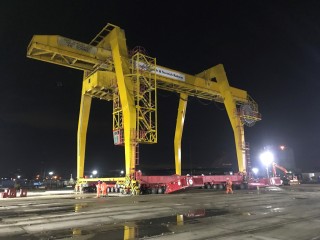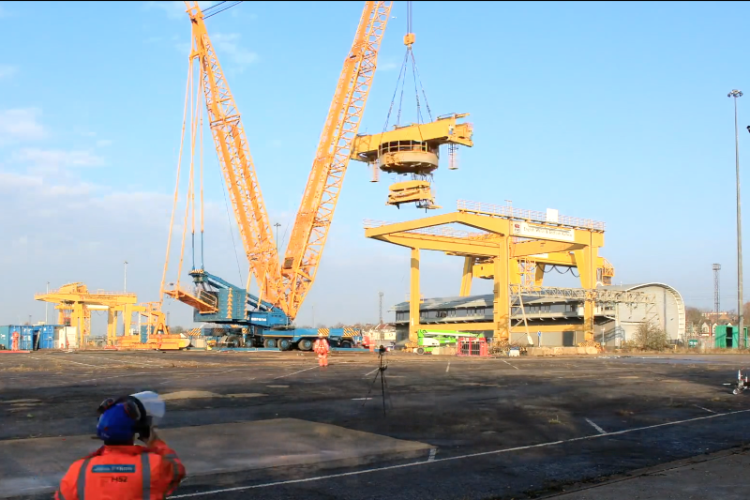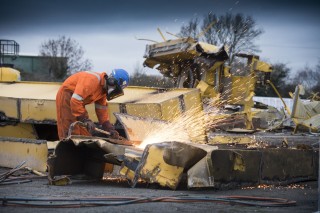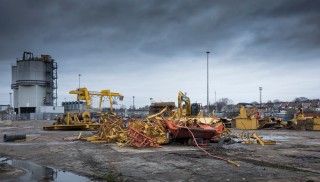The 22-metre high gantry cranes – each weighing up to 290 tonnes – have been familiar landmarks familiar to rail passengers travelling into Euston over the past 25 years.
Each one had to be lifted and moved up to 100 metres, so they could be safely dismantled away from the neighbouring rail track.
HS2 Ltd says that the removal of the three cranes was one of the most complex engineering challenges the project has faced so far, requiring thousands of hours of planning and preparation.
Once complete, 16 freight trains a day are expected to serve the planned rail logistics hub, delivering equipment and construction materials and removing tunnel boring machine spoil.
In total, the 150,000 m2 rail hub is expected to process more than six million tonnes of excavated material – the equivalent of taking 300,000 HGVs off the roads.
HS2 project director Colin Thomas said: “Once up and running, the rail logistics hub will be the beating heart of our construction activity in the capital, enabling us to deliver equipment and materials and take out huge amounts of excavated material by rail.
“The safe and efficient removal of the Willesden cranes is the first step to making that possible, and a very visible reminder of the progress we are making in the delivery of Britain’s new high speed line.”
HS2’s enabling works contractor, a Costain Skanska joint venture (CSjv), working with demolition specialist JF Hunt Ltd and ALE Heavy Lift, used a 550-tonne class mobile crane supplied by Sarens to move the first two container cranes last year.
The third – and heaviest of the container cranes – was moved by the same team over live railway lines during the Christmas break using a specialist motorised jacking system.
As the client stipulated that the ‘state of the crane’ could not be altered in any way, and that there could be no impact on the train operations, a bespoke bracket was designed that could lift the crane from the jacking points underneath the bogies. Two of the crane legs had the potential to swing as they were secured only with a pin joint; the bracket solution resolved this by ensuring the structure would not be subjected to stresses beyond its design criteria.


ALE used 36 axle lines of self-propelled trailers in a 2x2 file 18 configuration with the bespoke brackets attached under the bogies to manoeuvre it approximately 40 metres clear of the rails. It was then placed onto a specially-made mock rail line foundation. The move took just 11 minutes.
“We faced more challenges than the usual port cranes moves we perform, which are typically rigid and don’t have the load bearing pressures capped,” said ALE project manager David Trigg. “Because of the complexities involved in this project, it was hugely rewarding to see all of the detailed planning come together.”
The crane was later brought down to ground level on the 6th February, in a controlled collapse.
After weakening the structure of the crane, the team used a 49-tonne excavator to pull the whole thing down onto specially built crash mats. This crane has now been disassembled at ground level, with 95% of the structure set to be recycled.
Neal Carter, PMO director at Costain Skanska Joint Venture (Csjv), said: “Costain and Skanska are making strong progress in preparing the area between Euston and the Colne Valley for the new HS2 route. The demolition of the third and largest crane marks the high point of a busy 12 months on site at Willesden.”
Originally known as Willesden Euro Terminal, the site was built to handle container traffic through the Channel Tunnel. The first scheduled freight train to cross the channel departed from Willesden on 27th June 1994, four months before the first Eurostar.
A fourth container crane, at the northwest end of the site, will be left in position.
The work is part of HS2’s early works programme, with more than 1,000 people at work across London, clearing the way for the start of construction. At Euston, demolitions are well underway alongside the project’s pioneering archaeology programme, while clearance of Washwood Heath, site of the project’s future rolling stock depot, is also in full swing.
Got a story? Email news@theconstructionindex.co.uk





